Comprehensive List of Researchers "Information Knowledge"
Department of Complex Systems Science
- Name
- NIIMI,Michiko
- Group
-
Philosophy of Information Unit
- Title
- Associate Professor
- Degree
- Dr. of Literature
- Research Field
- Environmental archeology / Faunal remains

Current Research
Relation between Man and Environment from Past to Present
OUTLINEEnvironmental archeology verifies the association of the environment with what surrounded our environment after the human race began. How should the association be made by the human race in the environment and the future? The relation between the people of the environments of former days will be made visible and examined. This study aims at new scientific analysis in addition to an archaeological technique to make Japan the main field by using the body of flora and fauna material of the excavation of ruins from prehistory to the modern ages.
TOPICS
1. Zooarcheology
Zooarcheology considers the relation between humans and animals from the analysis of animal remains (animal and fish bones, shells, etc.). People's defecatory remains from that time have also been excavated from ruins.
Production activities and the relation between the restoration of people's past eating habits and man and domestic animals, hunting, and fishing are also researched. For instance, now the wild boar is only hunted in winter, and that makes it to the"peony pan". However, many individuals who died in seasons other than winter have been discovered from the ruins of the Jomon age at the Atsumi peninsula. The death season of the excavated wild boar used to be presumed from the eruption exchange state of the lower jaw bone's molars, but now wild boar is believed to have been hunted all year round. Hunting season activity would provide human activity and distribute the village's manpower. It would also influence the constitution of society and the etiquette of the system. Such tools as bone corner machines and stone implements used for hunting and fishing are examined in parallel with the analysis of animal remains.
2. Botanical food
We consider how people in the Jomon age used plants, especially chestnuts and acorns. Chestnuts were an important food in the Jomon age. Changes in the pattern of the chestnut harvest and the amount of the harvest provided food acquisition, storage, and usage strategies for the Jomon people. Such changes must have greatly influenced the village's ideal way for the population and the territory. The majority of chestnuts, which were used for food in the Jomon age, is thought to be smaller than modern cultivated kinds. They are closer to wild chestnuts than present chestnuts. However, such data is unknown about the present wild Japanese chestnut. The collection investigation of wild chestnut (Castanea crenata) began in Aichi Prefecture in the autumn of 1999. So far, the change of the year of true size, the weight, the harvest amount of wild chestnuts, and the total harvest amount have been clarified. To further examine the wild chestnut region, in 2004 a similar investigation was done in Gifu Prefecture.
3. DNA analysis of floral and faunal remains
We consider society and culture of that time by using DNA information on excavated animals and plants from the ruins, and the ruin excavation chook was analyzed recently.
The chook of Japan is thought to introduce in the Yayoi age from the Chinese continent and its remains become popular in the Edo period. Recently, we can approach ways of ideal production, circulation, and chook consumption of that time from the attribute data of such batch material. Although the case where a large amount of chook bone is abandoned to a ruin site in Bunkyo Ward, bulk was found in Tokyo. Ancient DNA is analyzed to examine the features of this chook bone material with inherited respect.

Figure : Skull of excavated dog from ruins of Edo period
Career
- Michiko Niimi received a Dr. of Literature degree in Archeology from The University of Tokyo in 1994.
- She was a Research Assoc. of the Department of Literature at The University of Tokyo from 1994 to 1996 and a Research Assoc. of the Graduate School of Human Informatics at Nagoya University from 1996 to 2000.
- Since 2000, she has been an Assoc. Prof. of the Nagoya University Museum, Nagoya University.
Academic Societies
- Japanese Archaeological Association
- JSSSCP
Publications
- The taste of the Jomon chestnut (Castanea crenata), Zooarcheology, 23, pp. 103-111 (2006).
- Did Jomon people gather chestnuts everyday?, Zooarcheology, 22, pp. 65-72 (2005).
- The investigation on the annual fluctuation of nut production of wild Japanese chestnut (Castanea crenata), Archeology and Natural Science, 23, pp. 57-67 (2004).








